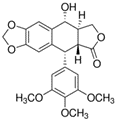INTRODUCTION
Podophyllotoxin is a non-alkaloid toxin lignan extracted from the roots and rhizomes of Podophyllum species. It is an organic heterotetracyclic compound that has a Furonaphthodioxole skeleton bearing a 3,4,5-trimethoxyphenyl substituent.
Manufacture
The two step manufacturing process involves extraction of crude Podophyllotoxin from harvested root of Podophyllum E.modi using suitable solvent followed by crystallization and oven drying.
| Synonym | 1,3,3a,4,9,9a-Hexahydro-9-hydroxy-6,7-(methylenedioxy)-4-(3′,4′,5′- trimethoxyphenyl)benz[f]isobenzofuran-3-one |
| Plant Source | Podophyllum E. Modi |
| Part of Plant | Root |
| CAS no. | 518-28-5 |
| EINECS no. | 208-250-4 |
| Molecular formula | C22H22O8 |
| Molecular weight | 414.41 |
| Structure |  |
Applications
| APIs |
|---|
| Podophyllotoxin is classified as ATC class: D06BB04 drug and is listed in WHO’s list of Essential Medicines |
| Antineoplastic and antiviral activities are the most pronounced pharmacological effects of Podophyllotoxin. It is a cytotoxic agent that binds to DNA and inhibits protein synthesis |
| Podophyllotoxin has also been shown to have anti-cancer effects in leukemia and other cancers, as well as being a potential anticancer drug for acute leukemia. It has been shown to induce oxidative stress and cell death in cancer cells |
| It is used for the topical treatment of genital warts in children and dermatological conditions caused by Psoriasis vulgaris as well as Molluscum contagisum infections |
| It may also be used as a therapeutic agent to treat genital tumors, Wilms tumors, lung cancer, and lymphomas |
SPECIFICATIONS
| Test | Unit | Specification |
|---|---|---|
| Appearance | Visual | White to off-white powder; no visible evidence of contamination |
| Identification by IR | – | To conform to structure |
| Melting point | °C | 175.0 – 185.0 |
| Assay by HPLC | % | Min 90.0 |
| Heavy Metals | ppm | Max 20.0 |
| % Volatiles by LOD (2 hours, 105°C under vacuum ) | % | Max 3.0 |
| Chromatographic Purity by HPLC | ||
| 4’-Demethylpodophyllotoxin | % | Max 8.0 |
| Specified impurity @ RRT 0.80 | % | Max 0.5 |
| Specified impurity @ RRT 1.34 | % | Max 1.0 |
| Specified impurity @ RRT 2.4 | % | Max 0.5 |
| Picropodophyllin | % | Max 0.5 |
| Individual unknown impurities | % | Max 0.5 |
STORAGE
Stored at 2 °C – 8°C
PACKING
15 kg UN approved cartons
REACH Status
Not registered
ExSyn offers Podophyllotoxin Crude on commercial scales under refrigerated transport and welcomes enquiries. No matter the quantity you need, our exceptional quality and service will make ExSyn your supplier of choice! If you need any additional information or SDS, please contact us.
5-Methyl-3-vinyl-2-oxazolidinone (V-MOX) is a highly reactive monomer valued for its low viscosity, mild odor, and excellent reactivity. It is widely used as a reactive diluent in UV-curable inks and coatings, where it enhances adhesion, produces brighter colors, and improves safety compared to conventional diluents. In addition, V-MOX serves as a key building block in the synthesis of kinetic hydrate inhibitor (KHI) polymers, which are applied in oil and gas production to prevent hydrate blockages in pipelines.
Zinc ricinoleate is the zinc salt of ricinoleic acid, a hydroxylated fatty acid derived mainly from castor oil (Ricinus communis). It appears as a white to slightly yellowish powder, waxy solid, or paste, depending on formulation. Its most valuable property is its ability to trap and absorb odor molecules such as amines, sulfides, and short-chain fatty acids, making it an essential ingredient in deodorant and odor-control products.
2-(tert-Butyl amino)ethyl methacrylate (TBAEMA) is a functional methacrylate monomer that contains a secondary amine group and a hydrophobic tert-butyl moiety, giving it excellent versatility in pH-responsive and adhesion-enhancing polymer systems.
It is valued in printing ink formulations for its ability to enhance adhesion, flexibility, and surface interaction.
Commonly known as potassium bis(fluorosulfonyl)imide (KFSI), the compound has a three-carbon backbone bearing six fluorine atoms and two sulfonimide (-SO₂F) groups. The molecule’s architecture lends it both high chemical stability and useful reactivity. Because of its excellent ionic conductivity and thermal / electrochemical stability, it finds use in advanced electrolyte formulations—for example in lithium-ion and next-generation batteries, in ionic liquids, and in other electrochemical systems.
Colchicine is a naturally occurring alkaloid obtained primarily from the autumn crocus (Colchicum autumnale) and related species. It has been used in medicine for centuries, especially for the treatment of gout and Familial Mediterranean Fever. In modern medicine, Colchicine is valued also in conditions like pericarditis, Behçet’s disease, and certain dermatological and cardiac disorders.
1-Butylimidazole is a versatile organic heterocyclic compound belonging to the imidazole family, where a butyl group (–CH₂–CH₂–CH₂–CH₃) is attached to the nitrogen atom at the 1-position of the imidazole ring. Its applications span organic synthesis, materials science, and bioactive compound development due to its tunable physicochemical properties and structural versatility.
Atropine sulfate monohydrate is a chemical compound, specifically a salt of atropine and sulfuric acid, with one water molecule (monohydrate) attached. It is commonly used as a medication and in research due to its anticholinergic properties, meaning it blocks the effects of acetylcholine at muscarinic receptors.
4-Aminobenzoic acid, commonly abbreviated as PABA, is an aromatic amine and carboxylic acid compound. It consists of a benzene ring substituted with an amino group (–NH₂) in the para position to a carboxylic acid group (–COOH).
2-Amino-5-Nitrophenol (5-NAP) is an organic compound with the molecular formula C₆H₆N₂O₃. It is a substituted phenol with both an amino group (-NH₂) and a nitro group (-NO₂) attached to a benzene ring, along with a hydroxyl group (-OH).
